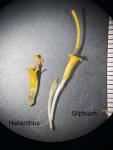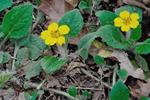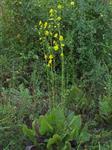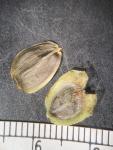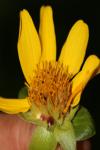Click the number at the start of a key lead to highlight both that lead and its corresponding lead. Click again to show only the two highlighted leads. Click a third time to return to the full key with the selected leads still highlighted.
1 Pappus present, of 5-60 barbellate bristles; receptacle naked (without paleae or well-developed bristles); [tribe Heliantheae; subtribe Eupatoriae]. |
..2 Plant a twining herb, phyllaries and disk florets 4 per head |
..2 Plant stiffly erect to sprawling but never twining, phyllaries and disk florets usually > 4 per head. |
....3 Leaves in whorls of 3-7, > 2 cm wide |
....3 Leaves opposite, rarely alternate or whorled, if whorled, < 2 cm wide. |
......4 Cypselae rostrate (with long beaks); the achene portion not bearing ribs |
......4 Cypselae not beaked, the achene variously ribbed. |
........5 Achenes (and ovaries) 8-10-ribbed; outer phyllaries longitudinally striate |
........5 Achenes (and ovaries) (3-) 4-5-ribbed; outer phyllaries not noticeably longitudinally striate. |
..........6 Heads pink to blue. |
............ 7 Phyllaries in 4-6+ series, deciduous |
............ 7 Phyllaries in 2-4 series, persistent (or deciduous in Praxelis). |
............ ..8 Heads pink (rarely bluish); receptacles flat; florets 18-25 per head; leaves sometimes gland-dotted |
............ ..8 Heads blue; receptacles conic; florets 25-70 per head; leaves gland-dotted. |
............ ....9 Bristles ca. 30; florets 35-70+; phyllaries ca. 25, subequal, persistent |
............ ....9 Bristles ca. 40; florets 25-30; phyllaries 15-25, unequal, deciduous (absence apparent in fruit) |
..........6 Heads white to cream or, rarely, pale lilac. |
............ ......10 Florets 3-7 per head |
............ ......10 Florets at least 9 per head. |
............ ........11 Phyllaries not strongly imbricate, with the principal ones subequal and sub-biseriate; petioles 0.5-10 cm |
............ ........11 Phyllaries clearly imbricate, in 3+ series, the margins usually glandular; some species epetiolate |
1 Pappus either absent, or of scales, setae, or awns; receptacle naked, paleate, or bearing bristles. |
............ ..........12 Leaves whorled, linear, < 2 mm wide; head solitary; [aquatic herb growing in shallow stagnant water] |
............ ..........12 Leaves opposite (or alternate in part), broader in shape and > 5 mm wide; heads typically not solitary; [terrestrial or wetland plants]. |
............ ............ 13 Receptacle naked (epaleate). |
............ ............ ..14 Pappus of 2-12 scales; heads white, pink, or blue (yellow in Schkuhria). |
............ ............ ....15 Heads with 20-125 florets; leaves serrate or ± dentate (at least distally); [rarely naturalized exotics or s. TX/FL natives]; [tribe Eupatorieae]. |
............ ............ ......16 Leaves petiolate; corolla tube glabrous, typically blue or lavender colored (sometimes white tinged); heads with 20-125 florets; [naturalized exotics or s. FL native] |
............ ............ ......16 Leaves sessile; corolla tube glandular-pubescent, typically white colored (sometimes pink-purple tinged); heads with 75-125 florets; [s. TX native] |
............ ............ ....15 Heads with 10-30 florets (or fewer in Schkuhria); leaves entire; [natives, of FL, s. GA, MS, and TX in our area]; [tribe Heliantheae; subtribe Chaenactidinae]. |
............ ............ ........17 Leaves 3-5 lobed (or foliolate); cypselae with curled hairs ( Florestina tripteris) or villous on angles ( Schkuhria pinnata); [s. TX in our area or ne. waif]. |
............ ............ ..........18 Heads discoid, corolla white; cypselae with curled hairs; [s. TX in our area] |
............ ............ ..........18 Heads discoid, sometimes with 1 (-2) diminuitive rays, corolla (of discs) yellow; cypselae villous, at least at bases or on angles; [waif of ne US, native in sw. US] |
............ ............ ........17 Leaves simple or unlobed; cypselae with straight hairs; [variously distributed in s. GA and FL w. to MO and s. TX] |
............ ............ ..14 Pappus none, or of a few bristles or irregular coroniform lobes; heads green to yellow. |
............ ............ ............ 19 Heads bright yellow, closely aggregated into corymbiform arrays of flat-topped to dome-shaped glomerules |
............ ............ ............ 19 Heads greenish or greenish yellow, borne in spiciform, racemiform, or paniculiform arrays. |
............ ............ ............ ..20 Heads in paniculiform arrays, all or most of the heads not subtended by bracts |
............ ............ ............ ..20 Heads in spiciform or racemiform arrays, each 1 (-2) heads subtended by a bract |
............ ............ 13 Receptacle with paleae or well-developed bristles. |
............ ............ ............ ....21 Heads small, less than 1 cm in diameter at anthesis (the female heads enlarging in Xanthium); disc florets dull white or suffused with green or purple; florets mainly unisexual (either in the same heads and then males central and females peripheral, or in separate female and male heads); female florets 0-8 per head; [tribe Heliantheae; subtribe Ambrosiinae] |
............ ............ ............ ......22 Heads unisexual; cypselas shed within an indurated bur or “nut” with hooked or straight spines developed from the phyllaries and/or paleae. |
............ ............ ............ ........23 Involucre of the female heads with tubercles or straight spines developing from the phyllaries; burs 1-8 mm long |
............ ............ ............ ........23 Involucre of the female heads with hooked spines developing from the phyllaries/paleae; burs 10-35 mm long |
............ ............ ............ ......22 Heads bisexual, with functionally male and female flowers in the same head; cypselas shed individually, not enclosed. |
............ ............ ............ ..........24 Heads in paniculiform arrays, all or most of the heads not subtended by bracts |
............ ............ ............ ..........24 Heads in spiciform or racemiform arrays, each 1 (-2) heads subtended by a bract |
............ ............ ............ ....21 Heads larger, mostly > 1 cm in diameter at anthesis; disc florets conspicuously white, yellow, pale yellow, or purple; florets mainly bisexual; female florets > 12 per head (except 2-8 in Polymnia and 8-15 in Verbesina occidentalis). |
............ ............ ............ ............ 25 Leaves strongly basally disposed, the basal-most leaves sitting almost flat on the ground and overlapping; disc flowers maroon-purple |
............ ............ ............ ............ 25 Leaves mainly or strictly cauline (not basally disposed); disc flowers white, yellow, or reddish-brown. |
............ ............ ............ ............ ..26 Disc flowers bright yellow or reddish-brown. |
............ ............ ............ ............ ....27 Involucre of phyllaries subtended by a calyculus of bracts obviously different in color, texture, and shape than the phyllaries. |
............ ............ ............ ............ ......28 Phyllaries usually distinct, rarely connate proximally; disk florets bright yellow |
............ ............ ............ ............ ......28 Phyllaries connate (both proximally-distally connate); disk florets yellow to reddish-brown |
............ ............ ............ ............ ....27 Involucre of phyllaries not subtended by a calyculus (phyllaries sometimes in 2+ series, but without obvious calyculi below). |
............ ............ ............ ............ ........29 Plants erect; heads without ray florets; [wet pine savannas and bogs; FL panhandle] |
............ ............ ............ ............ ........29 Plants primarily prostrate or trailing, sometimes erect; heads with or without ray florets; [habitats various, widespread natives and non-natives] |
............ ............ ............ ............ ..26 Disc flowers bright white or pale yellow. |
............ ............ ............ ............ ..........30 Stems not winged; plants erect or spreading. |
............ ............ ............ ............ ............ 31 Cypselae 3-4 angled; pappus falling (of 2-12 awns or bristles); leaf margins irregularly crenate to serrate, the surfaces sometimes roughened but lacking glands; [e. of TX] |
............ ............ ............ ............ ............ 31 Cypselae 5-ribbed; pappus absent; leaf margins entire or serrulate, the surfaces gland-dotted; [s. TX] |
............ ............ ............ ............ ..........30 Stems winged; plants erect. |
............ ............ ............ ............ ............ ..32 Disc flowers bright white; leaves unlobed or with 2 basal lobes |
............ ............ ............ ............ ............ ..32 Disc flowers creamy or pale yellow; leaves prominently pinnately lobed, with 5-many lobes |
1 Ray florets white, pink, or purple (rarely pale yellow or lavender). |
..2 Ray floret (the lamina) persistent on the achene and becoming papery and bleached |
..2 Ray floret (the lamina) articulate from the achene and falling, thus the mature heads not appearing papery. |
....3 Pappus of a minute crown (coroniform); disc florets white or whitish. |
....3 Pappus absent, of 1-many scales, or of retrorsely barbed awns (or plumose bristles in Tridax procumbens); disk florets yellow, red-brown, or pinkish. |
......4 Heads with an involucre not subtended by a calyculus. |
........5 Rays pink, the laminae 5-14 mm long; [OK and TX westward] |
........5 Rays white or whitish-yellow; the laminae typically < 5 mm long (occasionally longer in Polymnia); [collectively widespread] |
..........6 Plants larger, 50-150+ cm tall; perennials; leaves > 10 cm long, sometimes with winged petioles or clasping basal appendages; disc florets functionally staminate; [natives of higher-quality, limestone or novaculite habitats] |
..........6 Plants smaller, 2-40 cm tall or long (if stems > 40 cm then plants usually procumbent); annuals or perennials; leaves usually < 10 cm long, lacking winged petioles or clasping basal appendages; disc florets bisexual and fertile; [non-natives of disturbed habitats]. |
............ 7 Plants with leaves simple, unlobed; pappus either absent or of fimbriate to aristate scales; plants annual, erect |
............ 7 Plants usually with a mix of simple and 3-lobed leaves; pappus plumose; plants perennial, usually at least somewhat procumbent |
......4 Heads with an involucre subtended by a calyculus of bracts (these often but not always reflexed); the phyllaries often appearing somewhat translucent or of a distinctly different color, shape, or texture from the leafy colored bracts below; [tribe Heliantheae; subtribe Coreopsidinae]. |
............ ..8 Phyllaries connate for at least ¼ their length; heads with or without ray florets; [MS westwards in our area] |
............ ..8 Phyllaries distinct; heads with ray florets; [collectively widespread in our area]. |
............ ....9 Cypselas beaked, not strongly flattened, 7-30 mm long, with 1 groove per face; leaves highly dissected |
............ ....9 Cypselas beakless, more or less strongly flattened and also often winged, 1.2-16 mm long, with 0 or 2 grooves per face; leaves simple to highly dissected. |
............ ......10 Cypselas 2.5-16 mm long, usually not winged; pappus awns (if present) usually retrorsely barbed; rays white |
............ ......10 Cypselas 1.2-8 mm long, usually winged; pappus awns (if present) barbless or antrorsely barbed; rays pink, purple, or white |
1 Rays predominantly yellow, orange, or red (sometimes with some brown, maroon, or purple coloration as well). |
............ ........11 Receptacle naked, epaleate. |
............ ..........12 Leaves and phyllaries with large, scattered, embedded oil glands, making the plants strongly aromatic (the glands translucent in living plants, usually golden-brown or blackish in herbarium specimens); plants annual, decumbent and much branched from the base (except Tagetes, annual and generally erect and sparingly branched); [tribe Heliantheae; subtribe Pectidinae]. |
............ ............ 13 Leaves unlobed, entire or serrate. |
............ ............ ..14 Leaves coarsely toothed, mostly opposite (the distal alternate) |
............ ............ ..14 Leaves entire (though with marginal setae), opposite |
............ ............ 13 Leaves pinnately lobed or pinnatisect (pinnately divided nearly to the midrib but the leaflets not separate), the margins of terminal segments usually serrate (sometimes entire). |
............ ............ ....15 Pinnate leaf segments lanceolate, 3-10 mm wide; calyculus absent |
............ ............ ....15 Pinnate leaf segments linear, 1-3 mm wide; calyculus present, of linear bracts and subtending the involucre. |
............ ............ ......16 Phyllaries distinct to their bases, or nearly so; ray florets 5-8; heads borne singly or in pairs/triplets; leaf surfaces puberulent |
............ ............ ......16 Phyllaries connate > ½ their length; ray florets 5-21; heads borne singly; leaf surfaces glabrous to variously pubescent/floccose |
............ ..........12 Leaves and phyllaries lacking embedded oil glands, though smaller punctate glands sometimes present; perennial or annual plants, upright and little or moderately branched below the inflorescence. |
............ ............ ........17 Leaf surfaces densely scabrous and canescent; [s. TX westward] |
............ ............ ........17 Leaf surfaces glabrous to hirsute but never canescent; [collectively widespread] |
............ ............ ..........18 Leaves mainly basal or basally disposed (a few pairs low on the stem), the blades elliptic to ovate, the surfaces hirsute and stipate-glandular |
............ ............ ..........18 Leaves mainly cauline, the blades primarily linear, lanceolate oblanceolate, or occasionally oblong (if ovate, then leaves mostly cauline), the surfaces glabrous to strigose but not stipitate-glandular |
............ ............ ............ 19 Pappus absent or of 1-2 antrorsely-barbed or subplumose bristles; leaf blades usually lobed; [c. TX westward] |
............ ............ ............ 19 Pappus absent, of scales, or coroniform (if coroniform then with 6-8 barbellulate bristles as in Jamesianthus); leaf blades unlobed; collectively widespread, including c. TX] |
............ ............ ............ ..20 Heads smaller and many (10-300+), arranged into dense, flat-topped corymbs; disc florets 1-15; ray florets 0-2, the laminae inconspicuous; phyllaries 6 (-9), in 1 series; [collectively more widespread but absent from n. AL and wc. GA] |
............ ............ ............ ..20 Heads larger and fewer (< 9 per inflorescence), arranged singly or in loose corymbs; ray florets 6-14, the laminae conspicuous; phyllaries 12-18, broadly ovate, squarrose and in several imbricate series; [on calcareous substrates in n. AL and wc. GA] |
............ ........11 Receptacle paleate, with paleae, bristles, or scales. |
............ ............ ............ ....21 Disc florets functionally staminate (“sterile”, not producing cypselae), the style undivided, their ovaries much smaller than ovaries of the ray florets (which are functionally pistillate). |
 Show caption*© Swarochi Tathagath, some rights reserved (CC BY), uploaded by Swarochi Tathagath Show caption*© Swarochi Tathagath, some rights reserved (CC BY), uploaded by Swarochi Tathagath ............ ............ ............ ......22 Inner phyllaries prickly with straight or uncinate prickles, and each enveloping a cypsela and swelling into a bur-like structure |
............ ............ ............ ......22 Inner phyllaries unarmed, not becoming bur-like (though those of Melampodium do invest the fruit). |
............ ............ ............ ........23 Plants with tack-glands or pit-glands on stems, leaves, and/or phyllaries; [waif, e. TX; native further westward] |
............ ............ ............ ........23 Plants without tack-glands or pit glands. |
............ ............ ............ ..........24 Outer phyllaries orbicular, connate 1/4 - 1/3 of their lengths; [exotic, rare] |
............ ............ ............ ..........24 Outer phyllaries orbicular to lance-linear, not connate; [native, collectively widespread in our area]. |
............ ............ ............ ............ 25 Phyllaries in 2 series; pappus coroniform ( Chrysogonum) or absent ( Lindheimera) |
............ ............ ............ ............ ..26 Plants perennial, often trailing; pappus persistent, forming a minute, half-cup-shaped crown; [e. LA eastward, e. of MS river] |
............ ............ ............ ............ ..26 Plants annual, erect; pappus absent (cypselae with 2 pappus-like processes originating from cypsela wings); [w. LA westward, w. of MS river] |
............ ............ ............ ............ 25 Taller, robust plants, the stems usually 5-40 cm long at maturity, erect; pappus absent or of 2 awns. |
............ ............ ............ ............ ....27 Cypselae strongly flattened, borne in 2-3 series from the 2-3 series of ray florets |
............ ............ ............ ............ ....27 Cypselae thick, not flattened, borne in 1 series from the 1 series of ray florets |
............ ............ ............ ....21 Disc florets functionally bisexual (“fertile”, producing cypselae), the style divided, their ovaries as large as, or larger than, ovaries of the ray florets (which may be either functionally pistillate or completely neuter). |
............ ............ ............ ............ ......28 Ray corolla (the lamina) persistent on the achene and becoming papery and bleached. |
............ ............ ............ ............ ........29 Outer phyllaries with a stiff, maroon-colored subulate apex |
............ ............ ............ ............ ........29 Outer phyllaries lacking a stiff subulate apex. |
............ ............ ............ ............ ..........30 Leaf margins serrate or toothed; plant a perennial; cypselae subterete, 4-5 mm long; [natives] |
............ ............ ............ ............ ..........30 Leaf margins entire; plant an annual; cypselae 3-angled or flattened, 6-10 mm long; [non-native waifs] |
............ ............ ............ ............ ......28 Ray corolla articulate from the achene and falling after flowering. |
............ ............ ............ ............ ............ 31 Pappus of 20 plumose bristles 4-5 (-7.5) mm long |
............ ............ ............ ............ ............ 31 Pappus absent or of scales or awns (if with awnlike bristles as in Acmella, then these never plumose). |
............ ............ ............ ............ ............ ..32 Plants with tack-glands or pit-glands on stems, leaves, and/or phyllaries; [waif, VA and NC northward; subtribe Madiinae] |
............ ............ ............ ............ ............ ..32 Plants without tack-glands or pit-glands on stems, leaves, and/or phyllaries; [natives and non-natives, collectively widespread] |
............ ............ ............ ............ ............ ....33 Paleae not notably clasping the cypsela; cypselae notably flattened (or weakly compressed/angled in Guizotia); heads small, the receptacle 3-8 mm in diameter (ca. 10-15 mm in Guizotia). |
............ ............ ............ ............ ............ ......34 Pappus absent; ray laminae longer, 8-14 mm long |
............ ............ ............ ............ ............ ......34 Pappus persistent, of 2-3(-5) scales or awns; ray laminae shorter, 2-5 mm long |
............ ............ ............ ............ ............ ........35 Cypselae all alike, sharp-edged but not winged |
............ ............ ............ ............ ............ ........35 Cypselae dimorphic, those of the ray florets with lacerate wings |
............ ............ ............ ............ ............ ....33 Paleae either entirely enveloping and falling with each cypsela or conduplicate (V-shaped in cross section), the 2 sides of the V partially clasping the cypsela; cypselae flattened, terete, or angled; heads mostly larger. |
............ ............ ............ ............ ............ ..........36 Phyllaries apparently 4, the outer 4 foliaceous and forming a fused quadrangle which conceals the much smaller and narrower inner phyllaries (each inner phyllary subtending a ray floret); cypselae finely 32-40 ribbed |
............ ............ ............ ............ ............ ..........36 Phyllaries not as above, instead 5 or more and not forming a conspicuously fused quandrangle; cypselae angled or smooth (sometimes angled, but lacking many fine ribs) |
............ ............ ............ ............ ............ ............ 37 Paleae completely surrounding the cypselae of the disc florets, forming a perigynium or sac-like appendage |
............ ............ ............ ............ ............ ............ 37 Paleae conduplicate or partially enclosing the cypselae, but not forming a sac-like appendage. |
............ ............ ............ ............ ............ ............ ..38 Disc florets with hairy staminal filaments; pappus of 4-6 aristate to lacerate scales; [TX westward] |
............ ............ ............ ............ ............ ............ ..38 Disc florets without hairy staminal filaments; pappus absent or of 2-3 scales or awns (sometimes accompanied by up to 8-12 additional shorter scales in Helianthus and Simsia, but these readily falling); [collectively widespread]. |
............ ............ ............ ............ ............ ............ ....39 Rays primarily orange; [waif of FL, AL, and LA] |
............ ............ ............ ............ ............ ............ ....39 Rays primarily yellow; [natives and non-natives, collectively widespread] |
............ ............ ............ ............ ............ ............ ......40 Cypselae (of at least the disc florets) strongly flattened and generally also winged (thin-margined in Simsia). |
............ ............ ............ ............ ............ ............ ........41 Cypselae 3-7 mm long; erect herbs; stems often winged |
............ ............ ............ ............ ............ ............ ........41 Cypselae 1-2.5 mm ( Acmella) or 3.5-6 mm long ( Simsia); plants erect, decumbent, or prostrate; stems never winged. |
............ ............ ............ ............ ............ ............ ..........42 Phyllaries 8-15; cypselae 1-2.5 mm long; involucre ca. 3-6 mm in diameter |
............ ............ ............ ............ ............ ............ ..........42 Phyllaries 13-43; cypselae 3.5-6 mm long; involucre 5-16+ mm in diameter |
............ ............ ............ ............ ............ ............ ......40 Cypselae subterete, quadrangular, variously angled, or diamond-shaped in ×-section, not winged. |
............ ............ ............ ............ ............ ............ ............ 43 Ray florets pistillate (“fertile”). |
............ ............ ............ ............ ............ ............ ............ ..44 Erect herb; leaves entire or with a few teeth; peduncles < 3 cm long |
............ ............ ............ ............ ............ ............ ............ ..44 Creeping herb; leaves serrate and also mostly 3-lobed; peduncles 3-10 cm long |
............ ............ ............ ............ ............ ............ ............ 43 Ray florets completely neuter. |
............ ............ ............ ............ ............ ............ ............ ....45 {XXXX}; Leaf surfaces and ray laminae abaxially gland-dotted; [SC waif; native to sw. US] |
............ ............ ............ ............ ............ ............ ............ ....45 {YYYY}: CHECK FLORA TRANS-PECOS REGION |
............ ............ ............ ............ ............ ............ ............ ......46 Leaves linear, lanceolate, or ovate, almost always some leaves on a plant > 7 mm wide; plants from crowns, some species with thickened vertical storage roots (only H. tuberosus producing horizontal tubers); [collectively widespread in our area] |
............ ............ ............ ............ ............ ............ ............ ......46 Leaves linear, 0.5-7 mm wide; plants from slender horizontal tubers; [c. FL north to s. AL] |
